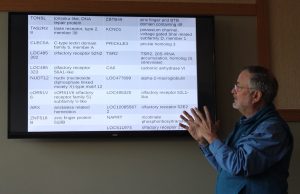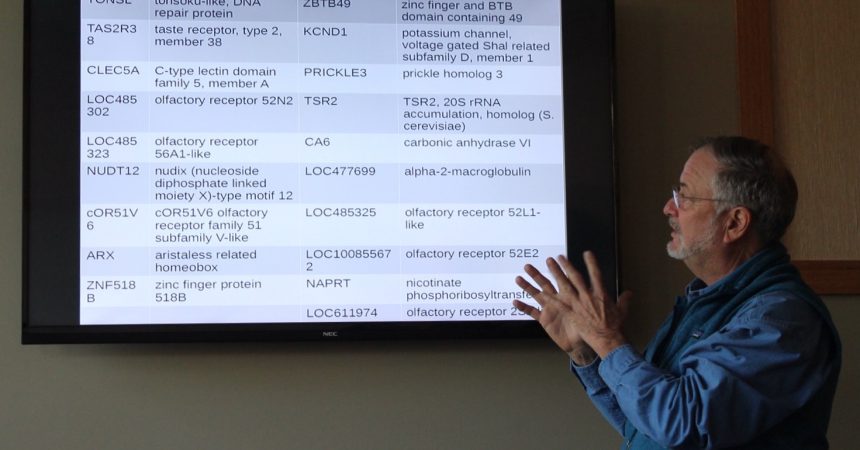Zoo InternQuest is a seven-week career exploration program for San Diego County high school juniors and seniors. Students have the unique opportunity to meet professionals working for the San Diego Zoo, Safari Park, and Institute for Conservation Research, learn about their jobs, and then blog about their experience online. Follow their adventures here on the Zoo’s website!
 Right around the same age I’m trying to discover my own passions, Dr. Oliver Ryder discovered his love for genetics. Dr. Ryder was first exposed to the ever-changing, exciting world of genetics in a high school science course. He learned that because of DNA’s specific structure, it could be replicated. He was captivated by this newfound knowledge and decided to pursue the subject in college. He earned his bachelor’s degree in Biology from the University of California, Riverside and his doctorate in Biology from University of California, San Diego. His ties with UCSD have continued long after his graduation, as he currently serves as Adjunct Professor in their Department of Evolution, Behavior, and Ecology. Simultaneously, he works as the Director of Conservation Genetics at the Institute for Conservation Research where he oversees the department’s myriad of research activities.
Right around the same age I’m trying to discover my own passions, Dr. Oliver Ryder discovered his love for genetics. Dr. Ryder was first exposed to the ever-changing, exciting world of genetics in a high school science course. He learned that because of DNA’s specific structure, it could be replicated. He was captivated by this newfound knowledge and decided to pursue the subject in college. He earned his bachelor’s degree in Biology from the University of California, Riverside and his doctorate in Biology from University of California, San Diego. His ties with UCSD have continued long after his graduation, as he currently serves as Adjunct Professor in their Department of Evolution, Behavior, and Ecology. Simultaneously, he works as the Director of Conservation Genetics at the Institute for Conservation Research where he oversees the department’s myriad of research activities.
Working in such a rapidly advancing field, Dr. Ryder’s own knowledge base is constantly expanding and evolving as well. In fact, the Conservation Genetics division didn’t even exist when he first joined the Institute. Collaboration is essential in the science community, which is why Dr. Ryder attends the Global Biodiversity Conference annually. Last month, he spent a week in Washington, D.C. at the conference speaking to fellow scientists pushing the boundaries of understanding and utilizing DNA. He described how it was an incredible opportunity to learn about the latest advances in genomics alongside people in similar fields. If you’re interested in learning more about the conference, check out this link http://biogenomics2017.org!
The invention of the microscope is known as a turning point in science, and I was intrigued to hear that Dr. Ryder considers the ability to sequence genomes an equally significant milestone for biology. Conservation Genetics focuses primarily on the process of speciation, the persistence of species and extinction risk. In their labs, they are able to look at DNA from almost any organism and organize its genetic data into a genome sequence. With a complete sequence, scientists have access to boundless amounts of information including population history, gene flow patterns, and the genetic diversity within the species.
This idea to sequence genomes was put into action with The Human Genome Project, which was successfully completed in 2003. Since then, millions of genomes have been sequenced. The project’s goal was to gain a better understanding of our own biology and genetic blueprint. This research has since been applied to medicine and disease prevention. The natural next step for the Conservation Genetics department was to explore if genome research could be used with endangered species and ideally augment their conservation efforts. In 2008, Dr. Ryder joined with two other scientists to organize a meeting to discuss the idea of sequencing 10,000 vertebrate genomes. Not long after, the Genome 10K project was born. The goal of Dr. Ryder’s team is to sequence the genomes of 10,000 vertebrate species to better understand the species’ genetic diversity. The link https://genome10k.soe.ucsc.edu provides further details about this amazing project if you’re seeking additional information.
Through his work, Dr. Ryder has been able to directly contribute to conservation efforts for species like California condors, black rhinos, black-footed ferrets, and bighorn sheep. So far, he believes that studying the DNA of condors has been his favorite project. Condors suffer from a recessive dwarfism disease called chondrodystrophy. With an endangered species, this occurrence cannot be overlooked. The Conservation Genetics department developed the first test for carriers of this lethal disease, and they are now using the test to identify and split up breeding pairs that are at greater risks of producing affected chicks. In the future, Dr. Ryder hopes to have the opportunity to work on saving the vaquita, a critically endangered species of porpoise. Becoming accidentally caught in fishing nets has had a serious impact on the species’ population, and there are now less than 100 individuals remaining. Additionally, Dr. Ryder would like to investigate why it is much harder to grow amphibian cells in tissue culture than it is for birds, reptiles, and mammals. He hypothesizes that the answer may lie in what the different pathway cells use to make enzymes. By exploring this, some indication of what is going wrong may be revealed. Genomics is an area that clearly has the potential to change our understanding of life in fundamental ways. Our perpetually growing knowledge in this field thanks to scientists like Dr. Ryder will ultimately allow us to be better stewards for the wildlife sharing our planet with us.
Jasmine, Career Team
Winter Session, 2017


